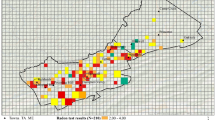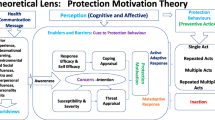Abstract
OBJECTIVES: To invite and support managers of child care centres to measure radon concentrations in their buildings. Their ability to carry out a measurement protocol and communication plan was also evaluated as well as the intention of parents and educators to test for radon at home.
PARTICIPANTS: Managers, parents and educators of child care centres.
SETTING: 36 child care centres located in two priority investigation areas in Québec.
INTERVENTION: A kit containing radon detectors with installation and recovery instructions was shipped by mail in addition to factsheets intended for parents and educators. Site visits and phone calls were also conducted with a sample of child care centres and participants.
OUTCOMES: The instructions related to detector installation were generally well respected. Afterward, more than half (18) of the 34 parents and educators interviewed said that they had been directly informed of this radon testing by managers or other educators, and not by the factsheet provided. This radon measurement intervention was considered very relevant by 91% of them and a quarter (26%) expressed their intention to test for radon at home, while 6% had already done so. Two child care centres (5.5%) had at least one measurement above the Canadian guideline level of 200 Bq/m3.
CONCLUSION: This intervention has demonstrated the ability of child care centre managers to carry out this type of autonomous procedure, which can be centralized to minimize costs. This type of intervention may influence parents to become more familiar with this contaminant and measure their family’s exposure at home.
Résumé
OBJECTIFS : Inviter les gestionnaires de centres de la petite enfance (CPE) à mesurer les concentrations de radon dans leur bâtiment et les soutenir dans leur démarche. Leur capacité à appliquer le protocole de mesure et le plan de communication a également été évaluée de même que l’intention subséquente des parents et éducateurs de mesurer le radon à domicile.
PARTICIPANTS : Gestionnaires, parents et éducateurs de CPE. LIEU: 36 CPE situées dans deux zones d’investigation prioritaire au Québec.
INTERVENTION : Des trousses contenant des dosimètres avec des directives d’installations et de récupération ont été envoyées par la poste de même que des feuillets d’information destinés aux parents et éducateurs. Des visites de contrôle et des appels téléphoniques ont également été complétés auprès d’un échantillon de CPE et de participants.
RÉSULTATS : Les directives de maniement des dosimètres ont été généralement bien suivies. Plus de la moitié (18) des 34 parents et éducateurs interrogés ont rapporté avoir été informés de ce dépistage par les gestionnaires ou d’autres éducateurs plutôt que par le feuillet distribué à cette fin. Cette intervention a été considérée comme très pertinente par 91 % d’entre eux et 26%ont exprimé leur intention demesurer le radon à domicile alors que 6 % l’avaient déjà mesuré. Deux CPE (5,5 %) ont présenté au moins une mesure au-dessus de la ligne directrice canadienne de 200 Bq/m3.
CONCLUSION : Cette intervention a démontré l’autonomie des gestionnaires de CPE à dépister le radon dans leur installation, permettant ainsi de réduire les coûts associés. Parmi les retombées, on compte également une meilleure sensibilisation des parents à ce contaminant accompagnée du désir chez plusieurs de le mesurer à domicile.
Similar content being viewed by others
References
Zeeb H, Shannoun F (Eds.). WHO Handbook on Indoor Radon: A Public Health Perspective. Genève, Switzerland: WHO (World Health Organisation), 2009;94 p.
NRC (National Research Council). Health Effects of Exposure to Radon, Committee on Health Risks of Exposure to Radon, BEIR VI. Washington, DC: National Academy Press, 1999; 578 p.
Kendall GM, Smith, TJ. Doses to organs and tissues from radon and its decay products. J Radiol Prot 2002;22(4):389–406. PMID: 12546226. doi: 10.1088/0952-4746/22/4/304.
Bissett RJ, McLaughlin, JR. Radon. Chronic Dis Can 2010;29(1):38–50.
US EPA (United States Environmental Protection Agency). EPA Assessment of Risks from Radon in Homes. Washington, DC: Office of Radiation and Indoor Air, 2003. EPA 402-R-03-003.
International Agency for Research on Cancer. IARC Monographs on the Evaluation of Carcinogenic Risks to Humans. Volume 100D. A Review of Human Carcinogens: Radiation. Lyon, France: IARC, 2009.
Chen J, Moir D, Whyte J. Canadian population risk of radon induced lung cancer: A re-assessment based on the recent cross-Canada radon survey. Radiat Prot Dosimetry 2012;152(1-3):9–13. doi: 10.1093/rpd/ncs147.
Krewski D, Lubin JH, Zielinski JM, Alavanja M, Catalan VS, Field RW, et al. Residential radon and risk of lung cancer: A combined analysis of 7 North American case-control studies. Epidemiology 2005;16(2):137–45. PMID: 15703527. doi: 10.1097/01.ede.0000152522.80261.e3.
Darby S, Hill D, Auvinen A, Barros-Dios JM, Baysson H, Bochicchio F, et al. Radon in homes and risk of lung cancer: Collaborative analysis of individual data from 13 European case-control studies. BMJ 2005;330:223–27. PMID: 15613366. doi: 10.1136/bmj.38308.477650.63.
Health Canada. Government of Canada Radon Guideline, 2009. Available at: http://www.hc-sc.gc.ca (Accessed October 23, 2015).
Statistics Canada. Household and the Environment Survey 2011. Ottawa, ON: Statistics Canada Catalogue, no. 11-526-x, 2013.
Brannigan E. Radon remediation in Northern Ireland. Environ Radon Newsl 1999;21:2.
Dessau J-C, Gagnon F, Lévesque B, Prévost C, Leclerc J-M, Belles-Isles J-C. Le radon au Québec, Évaluation du risque à la santé et analyse critique des strategies d’intervention. Québec: Direction des risques biologiques, environnementaux et occupationnels, Institut national de la santé publique du Québec, 2004. ISBN: 2-550-43891-4.
Gagnon F, Courchesne M, Lévesque B, Ayotte P, Leclerc J-M, Belles-Isles J-C, et al. Assessment of the effectiveness of radon screening programs in reducing lung cancer mortality. Risk Anal 2008;28(5):1221–30. PMID: 18761730. doi: 10.1111/j.1539-6924.2008.01105.x.
Poulin P, Leclerc J-M, Dessau J-C, Deck W, Gagnon F. Radon measurement in school located in three priority investigation areas in the province of Quebec, Canada. Radiat Prot Dosimetry 2012;151(2):278–89. PMID: 22279199. doi: 10.1093/rpd/ncr483.
Lévesque B, Gauvin D, McGregor RG, Martel R, Gingras S, Dontigny A, et al. Étude d’exposition au radon222 dans les résidences de la province de Québec. Québec: Centre de santé publique de Québec. Société canadienne d’hypothèques et de logement, 1995.
Drolet J-P, Martel R, Poulin P, Dessau J-C. Methodology developed to make the Quebec indoor radon potential map. Sci Total Environ 2013;1(473-474):372–80.
Health Canada. Guide for Measurement in Public Buildings (Schools, Hospitals, Care Facilities, Detention Centres). Ottawa, ON, 2008; 22 p. ISBN: 978-0-662-04429-1.
Matuszek JM, Hutchinson JA, Lance BH, Virgil MG, Mahoney, RJ. Standardization of radon measurements. Environ Int 1988;14(4):371–78. doi: 10.1016/0160-4120(88)90018-9.
Poortinga W, Cox P, Pidgeon, NF. The perceived health risks of indoor radon gas and overhead powerlines: A comparative multilevel approach. Risk Anal 2008;28(1):235–48. PMID: 18304120. doi: 10.1111/j.1539-6924.2008.01015.x.
Environics Research Group. National Survey Concerning Radon and Indoor Air Quality. Rapport, no. ROP-443-06, 2007 (in French).
Laquatra J, Maxwell LE, Pierce M. Indoor air pollutants: Limited-resource households and child care facilities. J Environ Health 2005;67(7):39–43. PMID: 15794462.
Iakovleva VS, Karataev, VD. Radiation doses in children of the Tomsk region during inhalation of radon-222. Gig Sanit 2004;4:60–61. PMID: 15318619 (in Russian).
Health Canada. Cross-Canada Survey of Radon Concentrations in Homes, Final Report. Ottawa, ON, 2012. ISBN: 978-1-100-20115-3.
Fojtikova I, Navratilova Rovenska K. Influence of energy-saving measures on the radon concentration in some kindergartens in the Czech Republic. Radiat Prot Dosimetry 2014;160(1-3):149–53. doi: 10.1093/rpd/ncu073.
Bostrom A, Fischhoff B, Morgan, MG. Characterizing mental models of hazardous processes: A methodology and an application to radon. J Soc Issues 1992;48(4):85–100. doi: 10.1111/j.1540-4560.1992.tb01946.x.
Golding D, Krimsky S, Plough A. Evaluating risk communication: Narrative, vs. technical presentations of information about radon. Risk Anal 1992;12(1):27–35. PMID: 1574615. doi: 10.1111/j.1539-6924.1992.tb01304.x.
Author information
Authors and Affiliations
Corresponding author
Additional information
Acknowledgements: The Ministry of Family, which initiated and facilitated contacts with kindergartens and the authorities of the Directions de santé publique du CISSS des Laurentides and de l’Outaouais regions for their support. This work was funded by the Province of Quebec Ministry of Health and Social Services and the Institut national de santé publique du Québec (internal budget code: 7677).
Conflict of Interest: None to declare.
Rights and permissions
About this article
Cite this article
Gagnon, F., Poulin, P., Leclerc, JM. et al. Implementation of a radon measurement protocol and its communication plan by child care centre managers in Québec. Can J Public Health 107, e319–e325 (2016). https://doi.org/10.17269/CJPH.107.5339
Received:
Accepted:
Published:
Issue Date:
DOI: https://doi.org/10.17269/CJPH.107.5339




